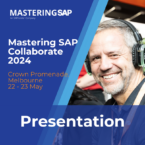SAP Workforce Planning
Filter By
Browse By
- SAP Analytics and AI
- SAP Application Development and Integration
- All SAP Application Development and Integration
- SAP ABAP
- SAP ABAP Development Tools
- SAP ABAP Test Cockpit
- SAP API Management
- SAP BAPI
- SAP Basis
- SAP BRF
- SAP Business Application Studio
- SAP CMS
- SAP Design Studio
- SAP Development Tools
- SAP DevOps
- SAP EAI
- SAP EDI
- SAP Extension Suite
- SAP Fiori
- SAP Fiori Elements
- SAP Integration Suite
- SAP Low Code Application Development
- SAP Low Code Automation
- SAP Netweaver
- SAP Release Management
- SAP UI5
- SAP Web Application Server
- SAP Web IDE
- SAP Business Process Management
- SAP Center of Excellence
- SAP CIO
- SAP Customer Experience
- SAP Data and Data Management
- All SAP Data and Data Management
- SAP BW
- SAP BW/4HANA
- SAP Crystal Reporting
- SAP Data Archiving
- SAP Data Center
- SAP Data Governance
- SAP Data Integration
- SAP Data Migration
- SAP Data Quality
- SAP Data Services
- SAP Data Strategy
- SAP Data Visualization
- SAP Data Warehouse Cloud
- SAP DMS
- SAP Document Control
- SAP EIM
- SAP ETL
- SAP ETL Tools
- SAP HANA
- SAP HANA Administration
- SAP HANA Deployment Infrastructure
- SAP HANA Studio
- SAP Master Data
- SAP Master Data Governance
- SAP MDM
- SAP Enterprise Architect
- SAP Enterprise Asset Management
- SAP ERP
- SAP Finance
- All SAP Finance
- SAP Accounting
- SAP AR AP
- SAP Asset Accounting
- SAP Billing Systems
- SAP BPC
- SAP BRIM
- SAP Cash Management
- SAP Central Finance
- SAP Controlling
- SAP COPA
- SAP Cost Center Accounting
- SAP e-invoicing
- SAP FICO
- SAP Finance Automation
- SAP Financial Closing Cockpit
- SAP Financial Consolidation
- SAP Financial Planning
- SAP FX Risk
- SAP General Ledger
- SAP Global Tax Management
- SAP Hyperion
- SAP Order to Cash
- SAP Payment Processing
- SAP Profitability Analysis
- SAP Rebate Management
- SAP S/4HANA Finance
- SAP Universal Journal
- SAP Governance Risk and Compliance
- SAP Human Capital Management
- SAP Intelligent Technologies
- SAP Platform and Technology
- All SAP Platform and Technology
- SAP Business Technology Platform
- SAP Cloud Connector
- SAP Cloud Integration Platform
- SAP Cloud Migration
- SAP Cloud Platform
- SAP Cloud Providers
- SAP Cloud Strategy
- SAP Container Platform
- SAP Digital Asset Management
- SAP Digital Integration Hub
- SAP Digital Signature
- SAP HANA Enterprise Cloud
- SAP HEC
- SAP Hyperscalers
- SAP Infrastructure
- SAP Messaging
- SAP Smart Forms
- SAP Quality and Testing
- SAP Security
- SAP Spend Management
- SAP Supply Chain Management
- All SAP Supply Chain Management
- SAP APO
- SAP Asset Management
- SAP Business Network
- SAP Digital Manufacturing Cloud
- SAP Digital Twin
- SAP EWM
- SAP IBP
- SAP Inventory Management
- SAP Label Printing
- SAP Logistics
- SAP Manufacturing
- SAP Manufacturing Automation
- SAP MES
- SAP MII
- SAP MM
- SAP MRO
- SAP MRP
- SAP Order Management
- SAP Plant Maintenance
- SAP PLM
- SAP Production Planning
- SAP S&OP
- SAP SD
- SAP SPM
- SAP Supply Chain Planning
- SAP Track and Trace
- SAP Transportation Management
- SAP System Administration
What Is SAP Workforce Planning?
Companies that want to better anticipate staffing needs — be they through organizational change, growth, or seasonal impact — use workforce planning. The process of workforce planning brings a data-driven approach to forecasting workforce requirements and strives to ensure a company is optimizing its hiring and training. Technology also plays a role in workforce planning, and SAP Workforce Planning is offered in the cloud-based SAP SuccessFactors Workforce Planning module.
Good workforce planning typically includes analysis of the following:
- Available talent
- Forecasted talent needs
- Gaps between what is forecasted and what is available
- Determination of how to fill talent gaps.
Filling talent gaps goes beyond simply hiring full-time workers. It can also include part-time or seasonal labor or contract work. The solution to workforce deficits may be inside the company already and achieved through training and promotion from within.
SAP Workforce Planning with SAP SuccessFactors Workforce Planning is one option for SAP customers, but it’s not the only option available. For example, vendors such as Alight offer pre-packaged workforce planning solutions. SAP partners like IBM and Accenture help companies implement workforce planning processes and technologies.
What Is SAP Workforce Planning?
Companies that want to better anticipate staffing needs — be they through organizational change, growth, or seasonal impact — use workforce planning. The process of workforce planning brings a data-driven approach to forecasting workforce requirements and strives to ensure a company is optimizing its hiring and training. Technology also plays a role in workforce planning, and SAP Workforce Planning is offered in the cloud-based SAP SuccessFactors Workforce Planning module.
Good workforce planning typically includes analysis of the following:
- Available talent
- Forecasted talent needs
- Gaps between what is forecasted and what is available
- Determination of how to fill talent gaps.
Filling talent gaps goes beyond simply hiring full-time workers. It can also include part-time or seasonal labor or contract work. The solution to workforce deficits may be inside the company already and achieved through training and promotion from within.
SAP Workforce Planning with SAP SuccessFactors Workforce Planning is one option for SAP customers, but it’s not the only option available. For example, vendors such as Alight offer pre-packaged workforce planning solutions. SAP partners like IBM and Accenture help companies implement workforce planning processes and technologies.
Key Considerations for SAP Workforce Planning
- Data-driven workforce planning is still a strategic advantage. While it may seem like every company is engaging in HR best practices that include workforce planning, the truth is workforce planning and analytics tools are among the lowest adoption of HR software types, according to data from our recent HR technology research. Implementing a workforce planning process can give your organization a competitive edge.
- Bring HR together with finance and the business for workforce planning. Workforce planning is at its best when all relevant sources of insight and information are brought to the table. Finance can provide critical data on budget and forecasted company performance. Business executives drive the direction of the organization that will ultimately create staffing needs. Combine business and finance with HR’s insight for the best workforce planning outcomes.
- Define your workforce planning requirements. Determining the goals of your workforce planning program before undertaking the actual analysis will help drive more effective results. Figure out which departments and skill sets are most likely to need planning assistance. Additionally, identify specific time frames for planning — are you looking at the next year or beyond?
16 results
-

CITIC Pacific Mining: An org charting customer success story
Published: 30/September/2024
Reading time: 1 min
CITIC Pacific Mining, a major mining company in Australia with over 2,000 employees, faced challenges in maintaining accurate HR data and visualising organisational structures. They adopted Navigo’s org.manager to automate and enhance workforce management, improving data governance and reducing administrative overhead. The solution enabled real-time visualisation, complex reporting, and secure collaboration, streamlining organisational changes. Over…
-

Data cleansing: Improve data quality and simplify system migrations
Published: 27/June/2024
Reading time: 1 min
In today’s data-driven world, accurate and up-to-date organisational data is crucial for informed decision-making and seamless system migrations. However, challenges such as outdated and inconsistent data can lead to inefficiencies and project delays. The org.manager tool offers a solution with features for data quality reporting, visual analysis, and iterative cleansing processes. By automating data transformation…
-

- SAP Workforce Planning
 Premium
Premium
Position Based Management to Improve Business Alignment
Part of this was a manager education issue but part of it was also lack of process. Implementing a position creation process using SuccessFactors EC workflows and business rules helped strengthened the process side and it was also an opportunity to address the manager education side. Of course, this hasn't meant things are now 100%…
-
-

Organisational Efficiency: CITIC Pacific Mining’s HR Innovation
Published: 07/March/2024
Reading time: 1 min
Discover how CITIC Pacific Mining’s partnership with Navigo transformed their HR processes with advanced org charting and data governance solutions.
-

Mastering Global Workforce Management: A Guide to Implementing a Global HR System
Reading time: 1 mins
In the face of rapidly globalising markets, this whitepaper articulates the necessity for a centralised global HR system, detailing the balance between universal functionality and local adaptability. It showcases Zalaris PeopleHub as a scalable solution that not only meets international compliance demands but also elevates the overall efficiency of HR operations.
-

Business Case Template – Org Design
Published: 01/August/2023
Reading time: 1 min
Writing a business case can be tricky when you don’t know where to start. A good business case is key to building your project’s credibility in the organisation. If you’re looking to educate your business about the benefits of using an org design tool, download Navigo’s free business case template.
-

Business Case Template – Org Design
Published: 01/August/2023
Reading time: 1 min
Writing a business case can be tricky when you don’t know where to start. A good business case is key to building your project’s credibility in the organisation. If you’re looking to educate your business about the benefits of using an org design tool, download Navigo’s free business case template.
-
-

Org Chart Best Practice Checklist
Published: 01/August/2023
Reading time: 1 min
Create effective org charts with this comprehensive checklist. Learn best practices for defining objectives, choosing platforms, and ensuring ongoing accuracy.
-

4 Steps to Conduct a Successful Spans and Layers Analysis in your Organisation
Published: 31/July/2023
Reading time: 1 mins
Optimize your organisation’s structure with a successful spans and layers analysis. Learn key insights and steps for effective implementation.
-

8 Steps to Implementing a Successful Restructure
Published: 31/July/2023
Reading time: 1 min
Discover the 8 key steps and workforce modelling techniques for a successful organizational restructure. Valuable insights for HR professionals.
Featured Experts
Become a Member
Unlimited access to thousands of resources for SAP-specific expertise that can only be found here.
Upcoming Events
-

SAP TechEd on Tour, powered by Mastering SAP
November 12 - 14, 2025
Sydney, New South Wales
Australia
View Event
Related Vendors
Your request has been successfully sent


